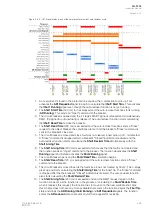
11. The circuit breaker is opened and the I> function's START signal is released, and
simultaneously the REQ1 trip signal for auto-reclosing is released. The function is now in a
steady lock-out state and waits for the user to manually reset and re-initialize the function by
closing the breaker.
Auto-recloser sequence from Start with two shots (high-speed fails, time-delayed
succeeds).
This auto-recloser scheme has the same starters and shots as the previous example. The setting and
signals are also the same. However, in this example the fault persists the high-speed shot but is cleared
by the time-delayed shot.
Figure. 5.4.4 - 188. Settings for I> with two shots.
This type of sequence (i.e. two shots required to clear the fault) represents 10...15 % of all faults that
occur in MV overhead line networks.
Figure. 5.4.4 - 189. Signal status graph of the semi-permanent overcurrent auto-recloser cycle.
1. An overcurrent is found in the protected line causing the I> protection to pick up. This
activates the AR1 R
AR1 Request
equested
ed signal to begin to calculate the SSho
hot1 Star
t1 Start T
t Time
ime. This activates
the SSho
hot 1 Running
t 1 Running signal eventhough the auto-recloser function is not yet running.
A
AQ
Q-F205
-F205
Instruction manual
Version: 2.04
270
© Arcteq Relays Ltd
IM00013
Summary of Contents for AQ F205
Page 1: ...AQ F205 Feeder protection IED Instruction manual ...
Page 2: ......
















































